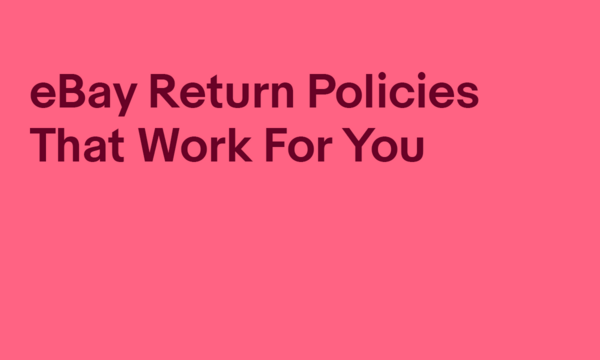Returns
Attract and retain buyers with a great returns policy.
How returns work
Get notified
We’ll let you know when a return is requested.
Track the return
Follow its progress on My eBay or Seller Hub.
Complete return
Issue a refund, replacement, or exchange.
Learn how to handle a return request with our step-by-step guide.
Overview
Managing returns on eBay is easy. When your buyer opens a return, we’ll first notify you through Messages and in My eBay. We then make it easy for you to provide a return label or offer an alternative resolution, such as a partial refund. Once you have received the item back, you’ll have plenty of time to inspect it and issue a refund, all of which can be done directly from your Return Details screen.
Seller tools for managing returns
Use these seller tools to manage your refunds and create a returns policy that attracts and retains buyers.
When you accept a return, you can provide a label for your buyer directly on eBay. Simply purchase a label from the courier of your choice and upload both the label and tracking number into the Return Details, and your buyer will be able to download it. By adding the label to your Return Details it makes it easier for eBay to track the status of the return and for us to answer any questions you may have.
After your item is returned, you can easily issue a refund directly from your Return Details screen.
Attract more customers with returns
A good returns policy can attract customers and keep them coming back. Here are some tips and features you can use to your advantage.

Meet buyers’ expectations
Many buyers expect a good returns experience that is consistent and competitive with a modern marketplace. When reviewing your returns policy options, be sure to choose the one that works best for you and your sales goals. You may choose to offer:
-
No returns accepted
-
30-day buyer-paid returns
-
30-day free returns
-
60-day buyer-paid returns
-
60-day free returns
-
14-day returns in limited categories
Learn more about setting up your return policy.
Offer free returns
A free returns policy is a great way to potentially attract more buyers and keep them coming back. Knowing that an item can be returned free of charge gives buyers the confidence they need to make a purchase.
Tools and resources
Returns FAQs
What if my listings don’t offer returns?
Even if you don’t offer returns, you may still receive a return request. If the buyer is returning the item due to remorse, you will have the option to decline the return. If your buyer claims the item arrived damaged, is faulty, or doesn’t match the listing, you will still need to resolve their issue. If you are unable to, the buyer can ask eBay to step in and help.
Who is responsible for return shipping?
The party responsible for obtaining a return label depends on your returns policy and the buyer’s reason for returning the item. Sellers are required to provide return shipping if the buyer claims the item arrived damaged, is faulty, or doesn’t match the listing. For all other return reasons, who is responsible for return shipping is determined by your return policy.
How can I make sure my buyer receives a Return Merchandise Authorization (RMA) number before they send the item back to me?
You can decide to offer a RMA number by checking the appropriate box in your Return Preferences page. We will ask you to provide the RMA number before the buyer can send the item back to you.
How can I issue an immediate refund for a return request instead of having the item sent back to me?
You can set up automation rules in your Return Preferences to immediately refund your buyer and let them keep the item.
How can I make sure that an item is returned to the correct location?
To ensure your items are shipped back to the correct location, it’s important that you always keep your return address up to date. You can update this in the “addresses” section of your account settings.
Please note that your return address set at the time the return was opened will determine where the item is sent. Once the return is opened, you cannot update the address.
